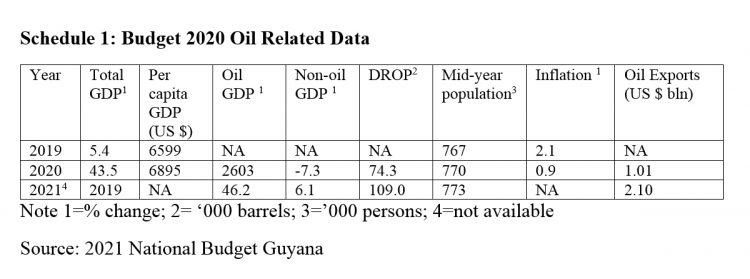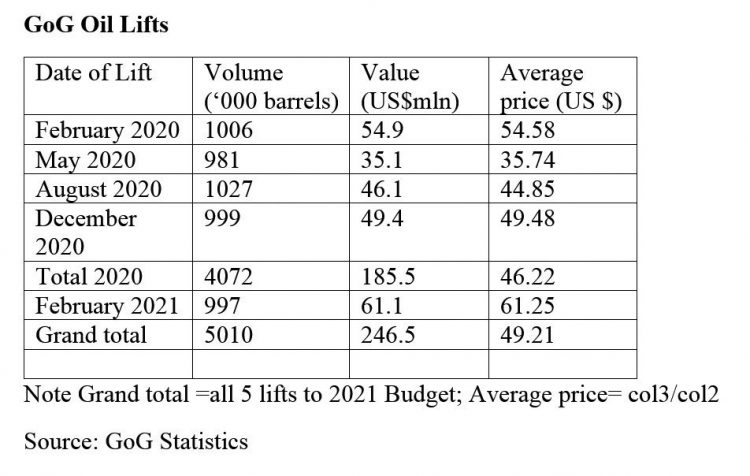Introduction
As indicated last week, starting with today’s column, I shift focus away from offering readers data and analytics rooted in instructional guidance on the political economy of Guyana’s emerging oil and gas. Henceforth, my primary thrust will be on timely intervention on arising issues. In essence my time horizon will shift from mostly longer-term learning objectives to the cut and thrust of ongoing exchanges. Readers may query the shift. My rationale is that this acknowledges the sector’s survival of the 2020 general crisis, along with its maturation over time.
I engage the treatment of Guyana’s oil and gas sector in the 2021 National Budget as the first topic. Readers who follow this Sunday column would recall I had given two earlier indications of this intent. First, the five-month delay in the installation of a new Government after the March 2020 national elections has reduced the 2020 National Budget (presented in September 2020) to an interim/emergency document. Second, as a result the 2021 National Budget has offered the new Government the first definitive opportunity for an authoritative pronouncement on data, analytics and policy prescriptions for the emerging oil and gas sector.
Obviously, I cannot properly address the Budget matters in a single column. Further, I believe that public expectations for an authoritative official pronouncement and serious debate remain high, especially in light of the pervading fog of noise and nonsense emanating from some sections of social and print media. Several of the Budget’s pronouncements on the oil and gas sector are direct and explicitly stated in the form of policy indications. However, quite a few are to be found in the official data it contains and released by the Government of Guyana, GoG as budget related releases.
National Budget Data
I’ll start with the latter as given in the paragraph above and describe a few of the notable macroeconomic inferences. The Budget reports total GDP growth rates for the two calendar years, 2019-2020, at 5.4 and 43.5 percent, respectively. These rates cover the two years; namely the year of First Oil (December 2019) and the 2020 general crisis year. During 2020, the Budget reveals the oil and gas sector and its support services contributed about 36 percent to Guyana’s total GDP, measured at 2012 purchaser prices. It is of note that, while the infant petroleum sector had supported the national growth rate at that unprecedented level, the Budget reports the growth rate of non-oil GDP had declined by 7.3 percent!
The Budget also reveals that Guyana’s emerging oil and gas sector and its support services grew by a whopping 2,6033.3 percent in 2020; a clear indication of the first full year of First Oil. The balance of payments data reveals crude oil exports totaled US$ 1.06 billion in value. Additionally, this is budgeted to more than double, reaching US$ 2.10 billion in 2021. Accompanying this outcome, crude oil’s daily rate of production, DROP, for 2020 had averaged 74,300 barrels. This amount is about three-quarters of the level projected in most analysts’ models and about two-thirds of the capacity reported by the grouping of international oil companies, IOCs, producers.
The Budget has targeted a Guyana real GDP growth rate of 20.9 percent for this year. It should be observed also that, the April 2021 IMF World Outlook report forecasts the 2021 global GDP growth rate at 6 percent. This rate is less than one-third of the projected rate for Guyana in its 2021 National Budget. Furthermore, 2021 non-oil GDP is projected to reverse course, growing by 6.1 percent! And with a reported mid-2020 population of 770,000 persons Guyana’s per capita GDP in 2020 was US$ 6,855
For readers’ convenience the data presented in this section are summarized in Schedule 1.
Government Revenue
In December last year, Canute James from Argus Media had reported that the media house was informed by the GoG in February 2020 that under the PSA, forecasted total oil revenue by year-end was US$300 million. And, it had reduced this forecast in July to US$200 million. The IDB Technical Note, (TN-1994)): Traversing a Slippery Slope: Guyana’s Oil Opportunity, August 2020, had forecasted GoG oil revenues for 2020 at US$300 million. These revenues are derived from three sources; namely, the signature bonus, royalties, and profit lifts of approximately one million barrels each. Initially, five such lifts were forecasted for 2020. The sum earned from each lift depends on the barrel price obtained from its sale.
The oil lift results are shown in Table 2:
Two timelines are displayed; namely: 1) from First Oil (December 26, 2019) to December 31, 2020, and 2) from First Oil to the presentation of the National Budget (February 12, 2021), which is the subject of this column. For, the first period a total of 4,072 thousand barrels of oil, in four lifts, were Guyana’s profit oil. These were sold for US$185.5 million. The average price obtained per barrel was US$46.22 And, for the second period a grand total of 5010 thousand barrels of oil, in five lifts, were Guyana’s profit oil. These were sold for US$49.21
The average price obtained per barrel varied with each lift; ranging from a low of US$35.74 for the May 2020 lift to a high of US$61.25 for the fifth lift
Other Oil Revenues
The signature bonus yielded US$18 million. And I compute the royalties at US$17.5 million for period 1 and US$21 million for period 2. The total PSA revenues are US$220.5 million and US$285.5 million, respectively, for periods 1 and 2
Conclusion
This analysis continues next week.











